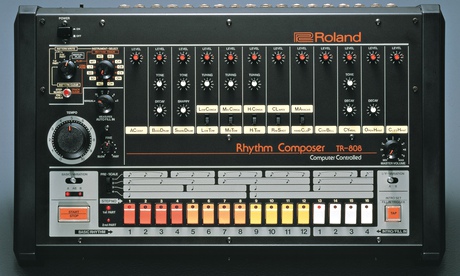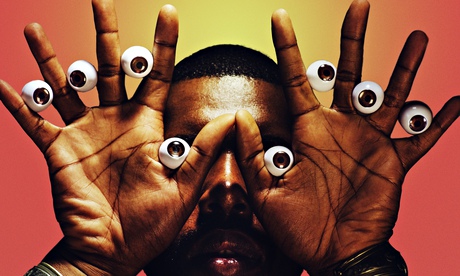The congas ring cheekily, the cowbell plays a corroded chime, the snare is parched and cruel – and the bass drum, a hard bloom of air, is barely music at all. With these core sounds, abetted by a handful of others, a simple drum machine gave house, techno and hip-hop the language it still speaks today.
The Roland TR-808 went out of production in 1983, even as the music that depended on it was being formed. Now Roland has resurrected it as the TR-8. The new model features all the sounds of the original as well as those of its successor, the TR-909 (there is also a relaunched version of the TB-303, the imitation bass guitar that acid house producers used to produce disturbing, squelching undulations). The 909 certainly left its mark, its hi-hats becoming one of the hallmarks of techno's froideur, but it's the 808 that remains the most iconic and influential.
Until the 808 became available in 1980, drum machines were something you put on top of a living-room organ to play along in time with. "Suddenly there was a move to make rhythm machines that could be used in the professional market, to break away from this preset bossa nova thing," says Sean Montgomery, a product manager at Roland. Roland aimed to recreate actual drum sounds, but the 808's drum sounds, created by running an electrical current through transistors, sounded very little like the real thing. "They did it the best they could with the analogue technology, and it sounded shit," says Montgomery with admirable frankness. The 808 went into commercial freefall.
But with units at low prices, relatively cash-strapped producers picked them up, and here the legend begins. Detroit techno producer Juan Atkins bought "the first 808 in Michigan" when he was still in high school, using it for his band Cybotron. "I had a class called Future Studies, about the transition from an industrial society to a technological society," he says. "I just applied a lot of those principles to my music-making." The 808 was the perfect tool for his future music, a "hi-tech funk" inspired equally by Kraftwerk and George Clinton, and was a cut above the primitive DR-55 drum machine he'd previously had. "The 808 allowed you to actually build your own patterns – you were able to put the kick drums and snares where you wanted them. It opened up a lot of creativity."
Meanwhile, in New York, Afrika Bambaataa and the Soul Sonic Force had recorded their 1982 hip-hop track Planet Rock, giving the nascent style a bright shaft of daylight between it and the funk that had come before. Greg Broussard, a producer in Los Angeles calling himself The Egyptian Lover, found out that it was the 808 that gave the track its distinct character and went to play with it at a local music store. "I programmed the Planet Rock beat and fell in love with this machine," he remembers dewily. "It blew me away. Everything sounded a bit toy-like, but at the same time it made you want to dance. I bought it right there on the spot." After a self-taught crash course, he played it live the next day in front of 10,000 people in a sports arena with his Uncle Jamm's Army DJ crew. "I didn't have any other instruments – the beat was moving the whole crowd. Thousands of people were dancing to this one little drum machine." Over in Detroit, Atkins was also feeding it into his sideline as a DJ. "We just took an 808 to the party, and made rhythm tracks on the fly – the place went crazy. It was something fresh, more than just playing a record."
It struck a chord as an instrument that truly reflected the 80s. "Home computers were coming on the scene, and it just fitted in with that," says Joe Mansfield, a drum machine collector who wrote this year's pictorial history Beat Box: A Drum Machine Obsession. "It sounded futuristic, what you thought a computer would sound like if it could play the drums." It began to seep into the mainstream, as the backbeat to Marvin Gaye's Sexual Healing, and across the Atlantic to the UK into, firstly, the industrial and post-punk scenes, where Graham Massey of Manchester acid house act 808 State first encountered it.
"It had that industrial heritage, but had that soul heritage," he says. "The Roland gear began to be a kind of Esperanto in music. The whole world began to be less separated through this technology, and there was a classiness to it – you could transcend your provincial music with this equipment." Massey made hip-hop with the 808, and then, because he couldn't afford anything else, used it for house too, making "dense, jungle-like" tracks that also deployed the 909. "On the 909 the kick was a bit more in your chest, a bit more of an aggressive drum machine. The 808 almost seems feminine next to it … the cowbell on the 808, that's the thing that says mid-80s R&B to me – SOS Band, big dancefloor anthems, which were a massive thing in the north-west of England. It wasn't just nerdy DJ culture, it was a 'ladies' night' kind of music."
The sounds became so much a part of dance music – where very often drums still don't sound like drums – that it's continued to endure, helped along by the digital versions made for production software. "Producers are searching through kits of tens of thousands of drum sounds and always coming back to the 808," says Mansfield. "It's embedded, it's constant." Hip-hop has continued to use it, with producers such as Lex Luger building intimidating 808 minimalism, and the juke artists of Chicago tapping its basic palette for their frenetically paced dance workouts.
These were heard by dubstep producer Tony Williams, inspiring his current Addison Groove project, which is based around the 808. "If you layer its bass drum, clap and snare on top of each other, it fills up such a specific but perfect frequency range that it sounds great in a club, at home, even on laptop speakers," he says. Previously using a software version, he bought an actual 808 instead of buying a new car when superclub Fabric asked him to play a live set with one. "I shouldn't really say this, but they've made it really easy to play live when you're drunk," he says in a languorous Bristolian drawl. "The sound palette is one of the best that's ever existed – whatever you do is probably going to make people dance. And I really enjoy that, because I like a drink."
The new incarnations are designed to continue this live heritage, as more producers gravitate from laptops towards the improvisatory potential of hardware. They're unlikely to entirely replace the original, though, with their pungent whiff of madeleine; Broussard, AKA, The Egyptian Lover, has now hoarded six 808s, and his voice turns soft and fond when he talks about them. "These machines are like my children – I could never get rid of them."
• Addison Groove's album Presents James Grieve is released on February 28 by 50Weapons. The Egyptian Lover realeases an anthology later this year by Stone's Throw Records. Juan Atkins plays London's Village Underground on March 8.
Top five TR-808 tracks
Cybotron - Clear
Kraftwerk's Hall of Mirrors gets lit up with lasers, as electro-rap production lifts off to the transcendent plains of techno and changes dance forever.
Egyptian Lover - Egypt, Egypt
Another Kraftwerk riff, this time on Tour De France, with Broussard turning the heavy breathing from that's track's cycling efforts into energetic sexual performance.
MCADE - How Much Can You Take
An example of the crushing power of the 808's low end, it takes John Carpenter's Halloween riff and lays it over posterior-vibrating Miami bass.
Freeez - IOU
The UK group took US digifunk and sold it back across the pond as this anthemic paean to, er, vowels. The 808 provides robust, nasty backbone against the androgynous vocals.
Addison Groove - Footcrab
Made with a software version of the 808, this scatters bits of the vintage sound palette across a relentlessly stuttering vocal sample to make a killer US-UK hybrid. BBT
This article was amended to remove Egyptian Lover's Freak-A-Holic from the top five, which was made using a Linn drum machine.










